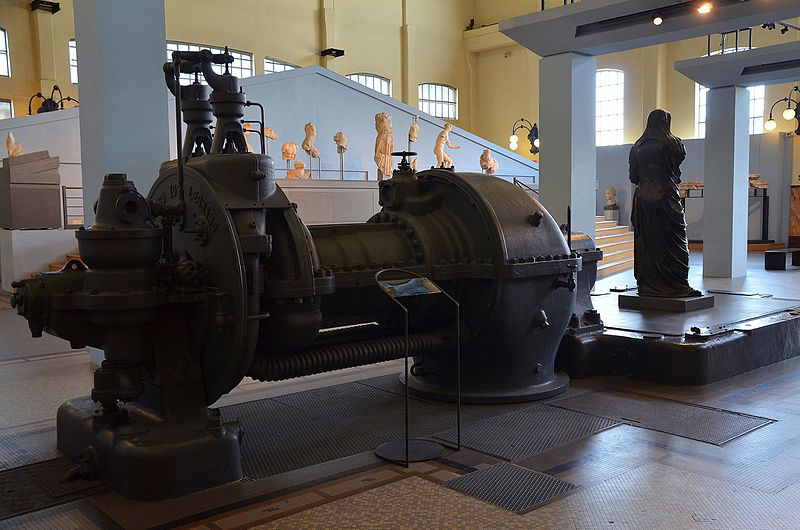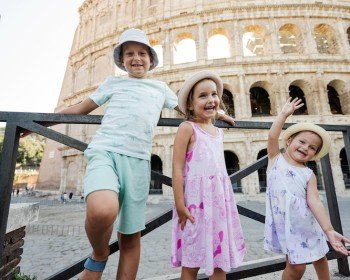In Italy, the first Sunday of every month, government places of culture such as Monuments, Museums, Galleries, Archeological Sites, Parks and Gardens offer free admissions to every visitor, it means that, for an entire day, those who want to dedicate themselves to discover the national cultural heritage have the all city -or nearly!- at their disposal. Of course most tourists would take advantage of this opportunity going to visit the Colosseum, or Capitoline Museums, Caracalla Bath, Ancient Ostia or Tivoli Villas...
I suggest you visit a peculiar place, part of the city museums, but set in an industrial archeology background: Centrale Montemartini. Since it is a place away from the usual tourist routes, and I think a quite unknown place between locals, you can really appreciate a visit in this sort of special Museum combining arts and settings from different eras.
Last Sunday - September the 2nd - was a Free Sunday, and as it was my day off, I tried to make the most of this opportunity... And so I went to visit Centrale Montemartini.
Located right along the left bank of the Tiber river, barely outside Testaccio district (or the 20th rione of Rome), the Montemartini thermoelectric power plant was born in 1912. Being the first public electric plant, it was placed where the city was having its best development of industrial power also thanks to its proximity to the Tiber river itself and to Roma Trastevere railway station.
The building, titled to an influential Italian economist - Giovanni Montemartini - looks majestic and monumental as the expression of the city pride. As a matter of fact, at that time, it was the only source to supply the entire city with services for the citizens: functional necessities and aesthetic values are perfectly mixed both inside and outside the structure. During Benito Mussolini's government the engine room was completely modernized, and even if during the II World War bombing was a little bit damaged, Centrale Montemartini was the only responsible of the electricity supply of the entire city during the Liberation of Italy, in 1945.

After almost 50 years activity Centrale Montemartini was declared obsolete and the electricity production was suspended. During the following years the building had been abandoned, until ACEA, an Italian energy and water supply company, decided to restore it with cultural aims and preserving its masonry and some machines that were displayed on site.
In 1997, due to a wide renovation of the Capitolini Museums, hundreds of statues were temporarily moved to the deserted Centrale Montemartini, launching the "Machines and Gods" exhibition which created a dialogue between classic archeology and the industrial one. Playing with contrasts, masterpieces of the ancient art production and artifacts discovered during archeological excavations in the 19th century and early 1930s were arranged next to old machinery; furthermore it was displayed the development of the city from the Republican era until the late imperial age. For the first time two art styles, diametrically opposed to one another, were pulled together: archeology and industrial archeology were set up in a bold way, combining everything so that space and objects to display, could stay intact without distorting each other.
People and authorized personnel showed so much interest in this intrepid experiment, that the exhibition became permanent in 2001, inaugurating the Centrale Montemartini Museum. Since then, the Museum became a detached branch of the Capitolini Museums and has been continuously expanded with new archeological finds and works, that have been kept in warehouses for years, away from the general public. An example of "secret works" could be the Roman sarcophagus, used in 2017 to set the new room "from the Myth to the Miracle"; every sarcophagus is embellished with illustrations from the myth representing the qualities of the deceased or in general figures that revoke bliss and calm of life after death.

In 2016 a new room was added, the one with the coaches of the train of the Pope Pius IX. In 1859, exactly on the 3rd of July, the train donated to the Pope and made up of these three couches, left from Porta Maggiore Station, at that time terminus of the papal railroads, and got to Cecchina Station, a small town located near Rome.
With the passing of the years the main characteristic of the museum remains this peculiar mix of industrial archeology and the classic one: machinery are the background to the sculptures and the other way round, depending on the position of the observer. The history of ancient Rome mingles with the more recent past creating a continuous dialogue between the splendour of ancient marbles and the majestic of the machinery, part of the old electric plant.
Nowadays the Museum goes on experimenting with new combinations, linking to the scientific research too.
Most works exposed at Centrale Montemartini come from archeological excavations conducted after Italy's unification. According to the organization of the exhibition you can distinguish the areas in which works were recovered and in particular three principal subjects: the republican period in the "Sala Colonne", the monumental center of Rome in the "Sala Macchine", gardens and imperial residences in the "Sala Caldaie".
And while walking, much more sections could grasp your attention! I am not an art student or passionate about archeology, but I am always attracted by these special not famous places it turns out to be the most fascinating parts of the city. Of course I am not saying the major highlights of the city doesn't worth a visit, the Colosseum or Caracalla bath are the core of the city, the crib of the ancient civilization, but sometimes it is intriguing going outside for a walk and find niche places exactly like Centrale Montemartini.
It is really interesting to look at the development of the archeology through an exhibition. You have the chance to see classic works combined with something that comes from a totally different sphere, like the industrial one, but it seems that this one is the right place for both to be!












